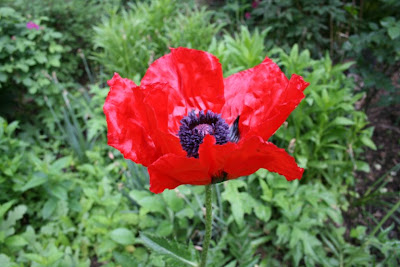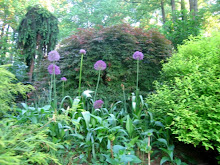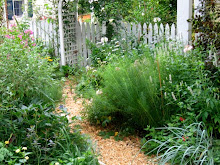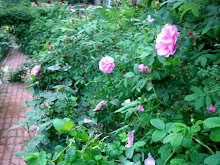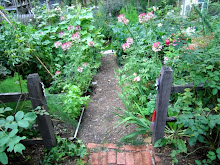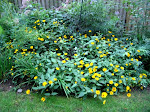Welcome to Heirloom Gardener
Sunday, June 22, 2008
Pictures of Heirloom Clematis Throughout my Garden
Posted by
Julia Erickson
at
4:14 PM
3
comments
![]()
![]()
Labels: Clematis, Cut and Forced Flowers, Summer Garden
Thursday, June 19, 2008
Swamp Darner Dragonfly among the Roses and Clematis
 Earlier this week, I saw an amazing dragonfly resting among the roses and clematis. I see a lot of dragonflies in the garden, but I've never seen one this large before. It was huge--almost four inches long, though I haven't figured out exactly which one it is yet. I'm working my way through the New Jersey Odanata Enthusiasts' website to try to determine which it is--perhaps some sort of Darner. If someone can identify it for me, let me know!
Earlier this week, I saw an amazing dragonfly resting among the roses and clematis. I see a lot of dragonflies in the garden, but I've never seen one this large before. It was huge--almost four inches long, though I haven't figured out exactly which one it is yet. I'm working my way through the New Jersey Odanata Enthusiasts' website to try to determine which it is--perhaps some sort of Darner. If someone can identify it for me, let me know!
Follow-up: I sent a picture of my dragonfly to the good people at the New Jersey Odanta Enthusiasts and they were able to identify my dragonfly as a Swamp Darner (Epiaeschna heros). Description: Huge. The size makes it almost unmistakable, but just in case, the blue eyes, prominent green thoracic stripes and brown abdomen ringed in green should remove all doubt.
Posted by
Julia Erickson
at
10:36 PM
6
comments
![]()
![]()
Labels: Wildlife in the Garden
Sunday, June 15, 2008
Garden Bloggers' Bloom Day - June 2008 (New Jersey): Roses, Eryngium, Linaria, and More
Here are some highlights from my garden for Carol's Garden Bloggers' Bloom Day June 2008: Star of the Republic is a wonderful rose introduced by Antique Rose Emporium. I usually do not like roses with apricot tones in them, but this one is beautiful. In addition, it blooms generously, is very disease resistant, and grows easily. She is planted in the triangle garden.
Star of the Republic is a wonderful rose introduced by Antique Rose Emporium. I usually do not like roses with apricot tones in them, but this one is beautiful. In addition, it blooms generously, is very disease resistant, and grows easily. She is planted in the triangle garden. An eryngium in the Front Border.
An eryngium in the Front Border. Russell's Cottage Rose is loaded with blooms that turn from deep pink to white as they age. Within each cluster of blooms you can often see a great variety of colors. This trait is quite common in the rosa multiflora hybrids. This along with their smooth canes makes multiflora hybrids my favorite climbers. She is planted in the Rose Garden.
Russell's Cottage Rose is loaded with blooms that turn from deep pink to white as they age. Within each cluster of blooms you can often see a great variety of colors. This trait is quite common in the rosa multiflora hybrids. This along with their smooth canes makes multiflora hybrids my favorite climbers. She is planted in the Rose Garden.
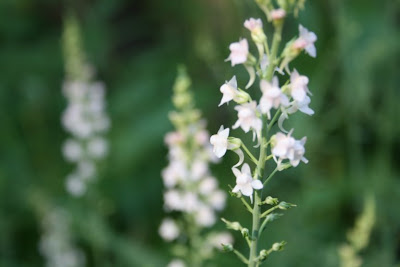 Lunaria is one of my favorite edgers. The upward spikes add verticals to the garden and the soft colors compliment anything.
Lunaria is one of my favorite edgers. The upward spikes add verticals to the garden and the soft colors compliment anything. 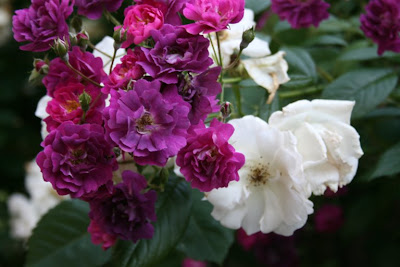 Violetta and Penelope grow together on an oblesk in the Rose Garden.
Violetta and Penelope grow together on an oblesk in the Rose Garden. 
Sea kale is a perennial vegetable that makes a wonderful impact in the garden. It's flowers reminds one of baby's brath.
Posted by
Julia Erickson
at
10:37 PM
6
comments
![]()
![]()
Labels: Garden Bloggers' Bloom Day, Poppies, Roses, Summer Garden
Thursday, June 05, 2008
Roses Blooming: Pictures of Rouletti, Louis Odier, Dortmund, Theresa Bugnet
To think before I became a gardener, I always was bewildered as to what time was good to go to the local botanical garden to see the roses. Now I cannot wait for the glorious roses that bloom in May and June. Here are some pictures of some of the roses blooming now.

 Rouletti is a small China rose that is always the first to bloom. It covers itself with soft pink slightly fragrant roses each spring and repeats strongly throughout the season. The leaves of Rouletti are very small giving the whole shrub a rather delicate appearance. I find Rouletti has to get good, continuous water or it will instantly begin to drop leaves. If it does, it is also quick to re sprout new ones after it gets more water. I usually trim it back at that point so it looks neater as it recovers.
Rouletti is a small China rose that is always the first to bloom. It covers itself with soft pink slightly fragrant roses each spring and repeats strongly throughout the season. The leaves of Rouletti are very small giving the whole shrub a rather delicate appearance. I find Rouletti has to get good, continuous water or it will instantly begin to drop leaves. If it does, it is also quick to re sprout new ones after it gets more water. I usually trim it back at that point so it looks neater as it recovers. Louis Odier grows along the fence of the Cutting Garden. It is a repeat blooming Portland that has big, extremely fragrant blossoms. The pink of its flowers is indescribably deep and rich. The spring bloom of Louis Odier is the best. But every year, its repeat bloom gets stronger and stronger. One of my Louis Odier roses is growing with a perennial sweet pea. The performance of that one is spectacular, probably due to the nitrogen fixing ability of the sweet pea. [Click here for a follow-up post with more information and a picture of the sweet pea.]
Louis Odier grows along the fence of the Cutting Garden. It is a repeat blooming Portland that has big, extremely fragrant blossoms. The pink of its flowers is indescribably deep and rich. The spring bloom of Louis Odier is the best. But every year, its repeat bloom gets stronger and stronger. One of my Louis Odier roses is growing with a perennial sweet pea. The performance of that one is spectacular, probably due to the nitrogen fixing ability of the sweet pea. [Click here for a follow-up post with more information and a picture of the sweet pea.] Dortmund is on the arbor to the Cutting Garden. It repeats strongly throughout the summer, the foliage is shiny and very resistant to fungal disease. It grows with two clematis: Betty Corning and Julie Correvon. On the picture you see the yellow buds of Danea, a hybrid musk, which has woven itself into Dortmund. Dortmund has wonderful sprays of roses which can by themselves create a vase of flowers. The only drawback to Dortmund is that it has big, hooked thorns which makes it unpleasant to prune.
Dortmund is on the arbor to the Cutting Garden. It repeats strongly throughout the summer, the foliage is shiny and very resistant to fungal disease. It grows with two clematis: Betty Corning and Julie Correvon. On the picture you see the yellow buds of Danea, a hybrid musk, which has woven itself into Dortmund. Dortmund has wonderful sprays of roses which can by themselves create a vase of flowers. The only drawback to Dortmund is that it has big, hooked thorns which makes it unpleasant to prune. Theresa Bugnet is usually one of the first to bloom. Its a rugosa rose. Each year I appreciate the rugosas more and more. They are great repeaters, strongly fragrant, and very healthy. With prompt deadheading and lots of water, Theresa Bugnet will bloom her heart out until the late fall when her leaves turn yellow and begin to drop.
Theresa Bugnet is usually one of the first to bloom. Its a rugosa rose. Each year I appreciate the rugosas more and more. They are great repeaters, strongly fragrant, and very healthy. With prompt deadheading and lots of water, Theresa Bugnet will bloom her heart out until the late fall when her leaves turn yellow and begin to drop.
Posted by
Julia Erickson
at
10:31 PM
3
comments
![]()
![]()
Labels: Cut and Forced Flowers, Roses, Summer Garden
Garden Vigilantes: Peter Rabbit Must Die
As a follow-up to my prior posts on deer, groundhog and rabbit control, the New York Times has a humorous article today on garden vigilantes entitled "Peter Rabbit Must Die" about peace-loving, tree-hugging gardeners becoming enraged, bloodthirsty critter killers, complete with a serious recipe for Woodchuck au Vin.
Posted by
Julia Erickson
at
7:54 AM
1 comments
![]()
![]()
Labels: Fun Stories About Gardening, Pest Control
Wednesday, June 04, 2008
Organic Pest Control: Threelined Potato Beetles, Colorado Potato Beetles, and Japanese Beetles
I could never imagine spraying inorganic chemical pesticides on vegetables or herbs that I am growing in my own raised vegetable beds. This year, two beetles have started to attack my potato plants. The more numerous of my beetles are the smaller (pictured) Threelined Potato Beetles (Lema trilineata).
The more numerous of my beetles are the smaller (pictured) Threelined Potato Beetles (Lema trilineata). They lay small yellowish eggs (pictured) on the underside of the potato leaves.
They lay small yellowish eggs (pictured) on the underside of the potato leaves. The other, larger beetle is the Colorado Potato Beetle (Leptinotarsa decemlineata).
The other, larger beetle is the Colorado Potato Beetle (Leptinotarsa decemlineata). These beetles lay somewhat larger, orange eggs (pictured), also on the underside of the potato leaves.
These beetles lay somewhat larger, orange eggs (pictured), also on the underside of the potato leaves. Organically controlling the beetle population is something that I have taught my children how to do, includes them in the vegetable tending process, and is an activity that they enjoy. Here's how to do it:
Organically controlling the beetle population is something that I have taught my children how to do, includes them in the vegetable tending process, and is an activity that they enjoy. Here's how to do it:
1. Fill a jar with soapy water.
2. Hold the jar under any beetles that you see.
3. If you bring your hand close to a beetle, it will have a natural flight response of dropping to the ground--or in this case, into your jar.
4. Once they fall into the soapy water, they lose the ability to fly and quickly sink to the bottom; in 5-10 minutes, you can rid yourself of dozens of these pests.
5. As for the eggs, check the undersides of your leaves; I find them sticky and difficult to remove, so I just tear off the leaves and stick them in the water too.
Side note: This method also works on the Japanese Beetles (Popillia japonica) that attack my roses in July.
Posted by
Julia Erickson
at
7:43 PM
28
comments
![]()
![]()
Labels: Gardening with Children, Heirloom and Organic Food, Pest Control, Pruning and Maintenance, Roses
Tuesday, June 03, 2008
My First Oriental Poppy of the Season
Posted by
Julia Erickson
at
10:32 PM
2
comments
![]()
![]()
Labels: Annuals/Biennials and Perennials, Cut and Forced Flowers, Poppies
Search Heirloom Gardener
Labels
- About Blogging
- Annuals/Biennials and Perennials
- Autumn Garden
- Books and Movies
- Botanical Gardens
- Bulbs and Tubers
- Children's Garden
- Chrysanthemum
- Clematis
- Container Gardening
- Crocus tommasiniasus roseus
- Cut and Forced Flowers
- Cutting and Rose Gardens
- Dahlias
- Deep Thoughts About Gardening
- Egg Garden
- Fences Arbors Walls and Paths
- Floral arrangements
- Front Border
- Fun Stories About Gardening
- Garden Bloggers' Bloom Day
- Garden Bloggers' Design Workshop
- Garden Planning
- Gardening Blogs
- Gardening Tools and Structures
- Gardening with Children
- Goldberry Hill
- Heirloom and Organic Food
- Hibiscus
- Holidays
- Hydrangeas
- Japanese Beautyberry
- Lilies
- Mixed Borders
- New Jersey / Local Interest
- Nurseries
- Online Gardening Resources
- Peonies
- Pest Control
- Picture This Photo Contest
- Piet Oudolf
- Poppies
- Propagation and Seeds
- Pruning and Maintenance
- Roses
- Seed Heads
- Self Seeders
- Shrubs
- Spring Garden
- Summer Garden
- Trees
- Wildlife in the Garden
- Winter Garden
- Zinia
Blog Archive
-
▼
2008
(202)
-
▼
June
(7)
- Pictures of Heirloom Clematis Throughout my Garden
- Swamp Darner Dragonfly among the Roses and Clematis
- Garden Bloggers' Bloom Day - June 2008 (New Jersey...
- Roses Blooming: Pictures of Rouletti, Louis Odier...
- Garden Vigilantes: Peter Rabbit Must Die
- Organic Pest Control: Threelined Potato Beetles, ...
- My First Oriental Poppy of the Season
-
▼
June
(7)

















